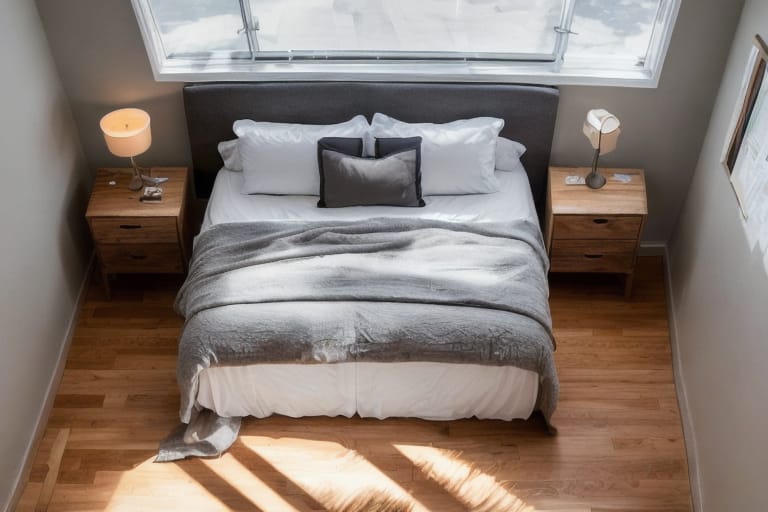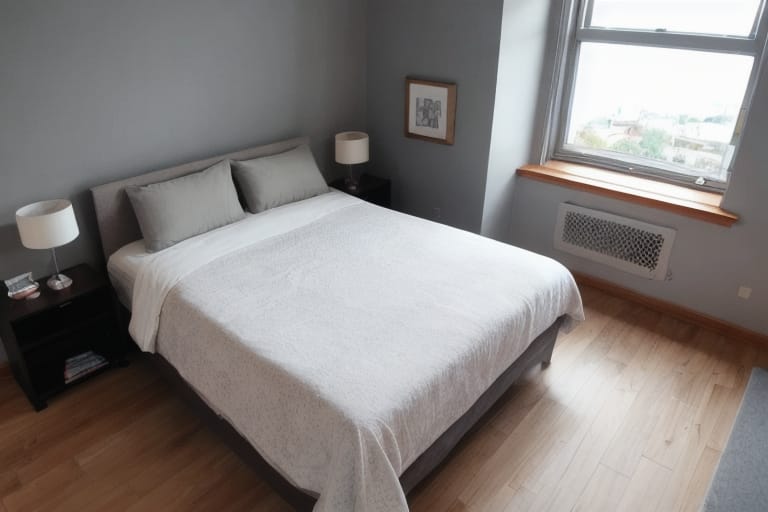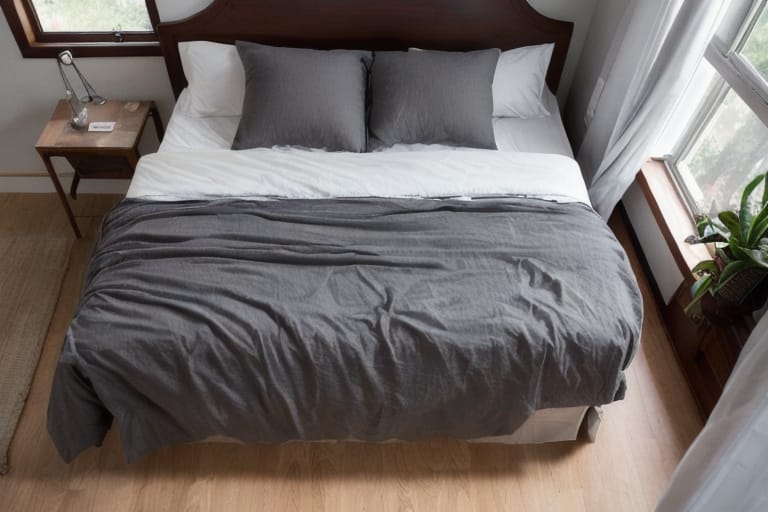Are you looking to add a cozy yet affordable comforter to your bedding? Down alternative comforters offer serious warmth and comfort without the high costs and allergy issues of regular down. Keep reading this beginner’s guide to find the perfect down alternative comforter to meet your needs and budget.
What is a Down Alternative Comforter?
A down alternative comforter uses synthetic materials to replicate the lightweight warmth and fluffiness of natural goose or duck down filling. The most common materials used are polyester fibers or recycled PET microfibers.
Down alternative comforters provide great insulation to trap body heat. Yet they remain breathable to prevent overheating. The fill is held in place by a shell fabric, usually cotton, cotton sateen, or microfiber.
Unlike regular down comforters, down alternative options are:
- Hypoallergenic – No bird proteins to trigger allergies
- Affordable – A fraction of the cost of down
- Easy to clean – Safe for machine washing and drying
- Ethical – No live plucking of ducks or geese
- Versatile for year-round use
Keep reading to learn all about down alternative comforter construction, benefits, care, costs and more to find your perfect match.
Materials Used in Down Alternative Comforters
There are two main components that go into a down alternative comforter:
Recycled PET Microfiber Fill
The filling consists of fine polyester fibers made from recycled PET plastic (like water bottles). The fibers replicate the airy loft and insulation of down.
PET plastic is spun into ultra-fine threads to make a breathable, hypoallergenic fill that avoids allergy triggers. It imitates the structure of down clusters.
Most quality down alternative comforters now use recycled PET fill rather than virgin polyester. This makes them an eco-friendly choice.
Cotton Sateen Shell
A woven cotton shell encases the fill. Premium options use ** cotton sateen**. It has a luxurious silky shine.
The cotton shell is very breathable. This allows body moisture to pass through. Cotton also enables great air circulation. So you don’t get too hot while sleeping.
Cotton cultivation does have some environmental impacts. But choosing organic cotton guarantees sustainable practices were used.
Construction of Down Alternative Comforters
Baffle Box Design
High end down alternative comforters feature baffle box construction. This means the fill is divided into separate quilt-like compartments:
- Baffle boxes evenly distribute fill so there are no cold spots
- They prevent the comforter from becoming lumpy over time
- Channels between boxes improve airflow and breathability
Baffle boxes also firmly hold the fill in place. So you won’t end up with bare spots on your comforter.
Corner Loops for Easy Duvet Attachment
Many down alternative comforters add corner loops or ties. These allow you to securely attach a duvet cover.
The loops keep the insert in place inside the cover. This prevents shifting around during the night.
Using a duvet cover not only decorates your bed. It also provides an extra protective barrier. Following the care instructions keeps your comforter like new for years.
Caring for a Down Alternative Comforter
Caring properly for your down alternative comforter ensures its longevity. Here are some top tips:
- Always check the included care label just in case
- Be extremely careful when moving pins, buttons etc. around bedding to avoid tears
- Use a duvet cover for added protection and to keep the fill evenly distributed

Down Alternative vs Down Comforters
For many years, down comforters were considered the best for softness and warmth. But down alternative comforters now give an extremely comparable experience:
While down still offers unmatched warmth for very cold climates, down alternative comforters provide excellent year-round warmth at a fraction of the price.
They are also far more convenient thanks to being hypoallergenic and machine washable.
Factors Impacting Down Alternative Comforter Pricing
There is quite a spectrum when it comes to down alternative comforter pricing. Costs are primarily driven by:
1. Materials Used
- 100% organic or sustainable materials = higher price tag
- Budget options may use cheaper poly-cotton blends
2. Construction Quality
- Number of baffle boxes
- Reinforced seams and stitching
- Usage of piping or ties
3. Overall Durability
- Densely woven shell fabric
- Heavier weight for better insulation
- Density and ounces of fill
4. Brand Reputation
- Big names like Brooklinen carry a premium
- Smaller direct-to-consumer brands can offer great value
Luxury options fetching over $250+ emphasize ethical production and sustainability. While cheaper comforters under $100 may skimp somewhat on quality or materials.
Top Environmentally Friendly Features
Eco-conscious shoppers should look for down alternative comforters with:
1. Recycled PET Fill
- Recycled plastic bottles get turned into silky fill
- Far more sustainable than virgin polyester
2. Organic Cotton Shell
- Grown without pesticides or chemical fertilizers
- Protects farmers and the environment
3. Sustainably Sourced Materials
- Responsible manufacturing practices
- Ethical working conditions and fair wages
4. OEKO-TEX Certification
- Rigorously tests for harmful chemicals
- Ensures non-toxic Processing from raw materials to finished product
Choosing a down alternative comforter made from recycled and organic materials is much better for the planet.
5 Top-Rated Down Alternative Comforters
1. Puredown All Season Reversible Comforter
- 650 fill power
- Box stitch baffle box design
- Soft microfiber shell
- Cost: $90 and up for Queen
2. Linenspa Reversible Quilted Comforter
- Hypoallergenic polyester microfiber fill
- Corner and side loops to attach duvet
- Medium weight for spring and fall
- Cost: $30 to $60 for Queen
3. Brooklinen Down Alternative Comforter
- 100% recycled PET fill
- Lightweight cotton sateen shell
- Premium responsibly-sourced materials
- Cost: $119 to $169 for Queen
4. Buffy Cloud Recycled Fiber Comforter
- Made from recycled water bottles
- 400 thread count cotton shell
- Cloud-like texture
- Cost: $170 for Queen
5. Cozy Earth Bamboo Comforter
- 300 thread count viscose bamboo cover
- Premium hypoallergenic fill
- Cost: $399 for Queen
There are excellent options across all budget ranges. Paying more yields premium materials, ethical production and lasting quality.

Frequency Asked Questions
Q: How do you wash a down alternative comforter?
A: Check the care tag, but most are machine washable. Use a gentle cycle on cold and low heat drying. Always use tennis balls to redistribute fill.
Q: Is down or down alternative warmer?
A: Natural down provides more insulation and traps warmth better. But down alternative maintains comparable warmth for much lower cost.
Q: Is down alternative hot to sleep with?
A: Not at all – the microfiber fill and cotton shell are very breathable to maintain a comfortable temperature all night.
Q: How long does a down alternative comforter last?
A: With proper care, a quality down alternative comforter will last over 5 years before needing replacement. Some premium options come with 10-year warranties.
Q: What thread count is best for a down alternative comforter?
A: For the shell, 300-600 thread count cotton or cotton blend is ideal. Bamboo viscose or microfibers can also create a smooth, breathable shell.








